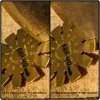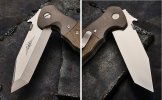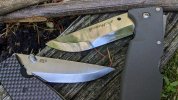Your answer will depend on where the guide block is placed on the blade, and the angle qualifier dps or inc (degrees per side or inclusive).
Example:
If for example "metal edge guide wheels" refers to a Richard Kell Bevel Gauge Image below, the gauge indicates bevel in degrees inclusive (inc) vs degrees per side (dps).
Kell Gauge measuring Left (Cold Steel Frontier Hawk) Right (Cold Steel Hudson Bay Hawk)
I ground both these hawks secondary bevels to 30inc aka 15dps (as illustrated in photo below)
View attachment 1900313
If your blade has a flat section where guide will rest A)
If your blade has a primary grind where your guide will rest B)
Your Answer:
A) If your guide block will be resting on a flat on the blade, the block should be at the measured dps of the existing grind (assuming you want to match existing).
B) If your guide block will be resting on a primary grind, you will need to know and compensate for the dps of the primary grind when using a guide block.
If B) Bevel angle you want to grind - primary grind angle = guide block angle



